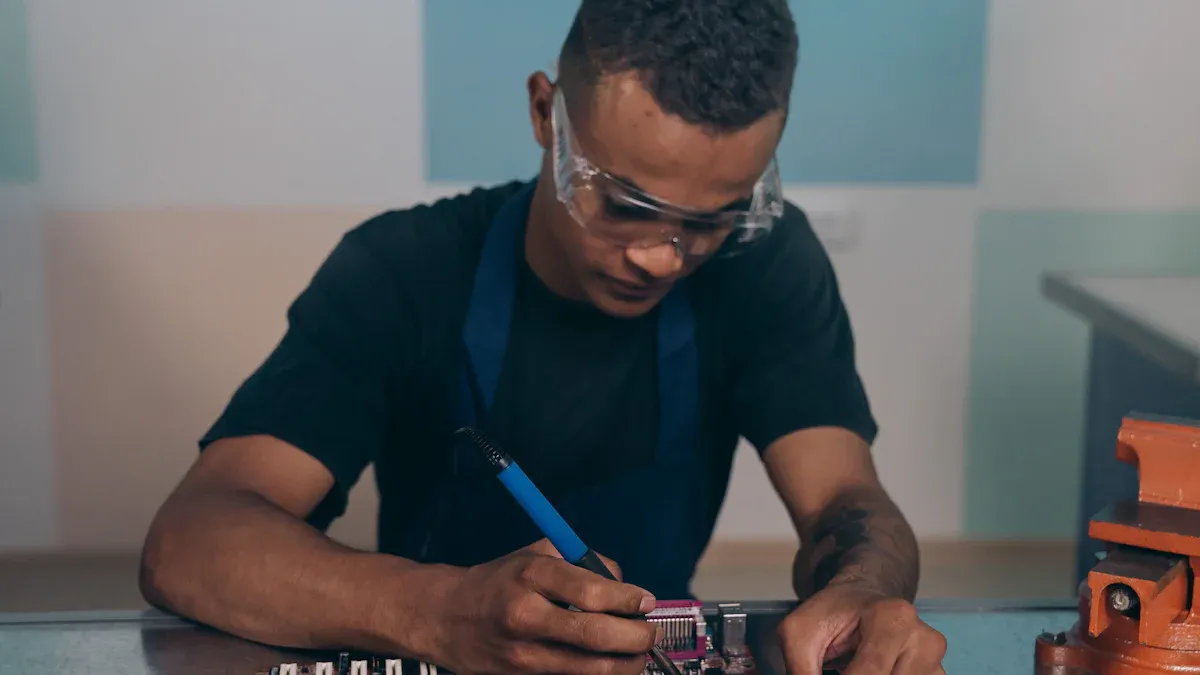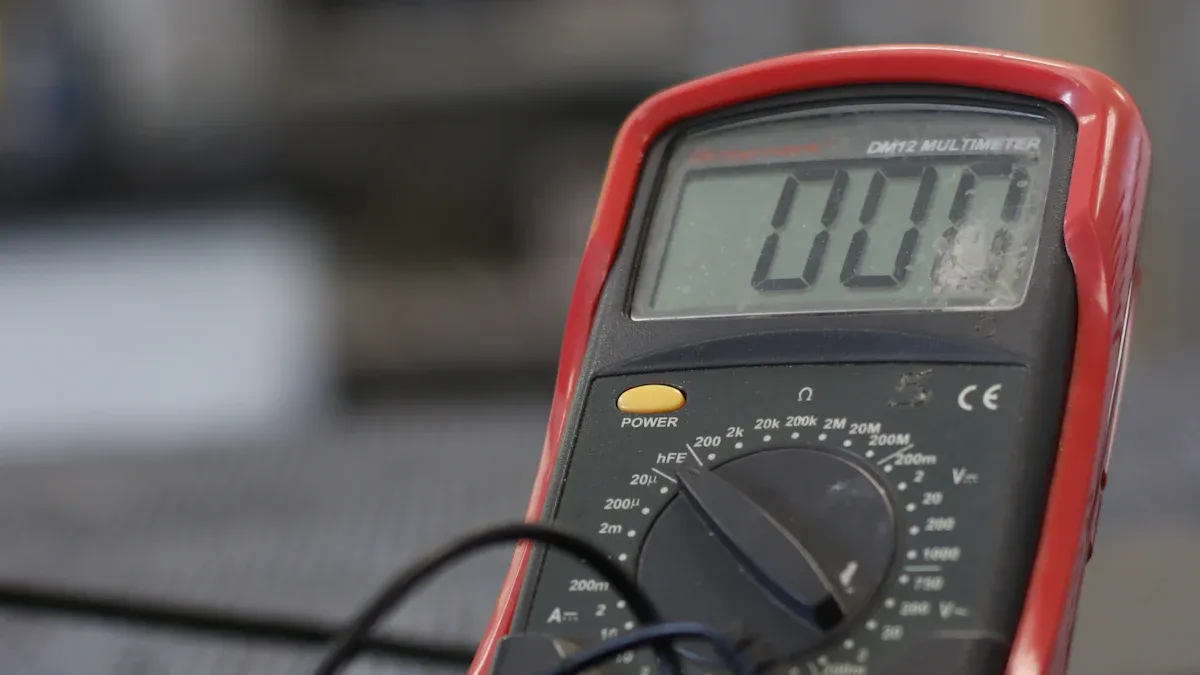You want confidence when choosing a manufacturer for flexible circuits assembly. The right decision protects your project from costly setbacks. Industry surveys show that common mistakes include ignoring bend radius requirements, improper material selection, and inadequate design for manufacturability. Other issues involve neglecting environmental factors, insufficient testing, and overlooking design rule checks. By understanding these risks, you ensure technical compatibility, reliability, and performance. As you read, keep your unique assembly needs in mind.
Key Takeaways
- Define your project requirements clearly. This helps avoid miscommunication and costly redesigns.
- Choose a manufacturer with strong technical expertise. Their knowledge can prevent mistakes and ensure reliability.
- Ensure your provider has the right certifications. This guarantees they meet industry standards for quality and safety.
- Ask about quality control processes. A commitment to quality ensures your flexible circuits perform reliably.
- Maintain open communication with your provider. Quick responses and support help keep your project on track.
Flexible Circuits Assembly Requirements
Before you evaluate any provider, you need to clarify your requirements for flexible circuits assembly. A clear understanding of your project needs helps you avoid miscommunication and costly redesigns. You set the foundation for a successful partnership when you define your technical, volume, and timeline requirements from the start.
Define Project Specifications
Start by listing your project needs in detail. Every flexible pcb assembly project has unique requirements, so you must consider electrical, mechanical, and environmental factors. Use the table below to guide your review of essential parameters:
| Parameter Type | Specifications |
|---|---|
| Electrical | Layer count, materials, impedance, shielding |
| Mechanical | Profile tolerances, bendability, flexible requirements, enclosure access |
| Environmental | Materials must withstand physical and environmental stresses |
| Thermal | Polyimide materials offer excellent thermal conductivity; review rigid materials for rigid flex |
| Performance class | Class 1, 2, or 3 requirements |
| Copper flexibility | Copper weight, materials, trace routing in bend areas |
| Coverlay | Mechanically drilled; adhesive squeeze out and coverlay registration |
| Trace Routing | Rounded corners, teardrops/fillets on pads |
| I-Beam effect | Stagger traces on adjacent layers to reduce copper stress |
| Trace transition | Avoid vias or transitions in bend/fold areas |
| Stiffeners | Overlap coverlay endpoint; epoxy at stiffener interface |
| Bend radius | Follow IPC 2223 bend radius rules |
| Surface finish | All common finishes compatible with polyimide materials |
| Testing | Electrical testing for continuity and impedance control |
Tip: Review your design requirements with your engineering team. Confirm that your chosen materials and layout meet both performance and reliability goals.
Set Volume and Timeline Goals
You also need to define your production needs and schedule. Estimate your total assembly volume and decide if you require prototypes, small batches, or full-scale production. Set clear delivery deadlines based on your project needs. Communicate these requirements early to ensure your provider can meet your expectations.
- List your expected order quantities.
- Set milestone dates for prototypes and final delivery.
- Identify any flexibility needed for future changes.
When you outline your requirements, you give providers the information they need to deliver a successful flexible circuits assembly. This step ensures your project stays on track and meets all technical and material needs.
Flexible PCB Manufacturing Capabilities

Choosing the right partner for flexible pcb manufacturing means looking beyond price and delivery. You need a provider with the right expertise, certifications, and technology to ensure your flexible circuits assembly meets every requirement. This section helps you evaluate manufacturer expertise and the advanced flex pcb assembly techniques that set industry leaders apart.
Technical Expertise & Experience
You want a manufacturer with deep expertise in flexible circuit technology. The best providers understand the unique challenges of flexible pcb manufacturing. They guide you through design for manufacturability, helping you avoid costly mistakes and delays. Their engineering teams can optimize your layout for both flexibility and reliability.
Industry experts highlight three critical areas of expertise for flexible pcb manufacturing:
| Expertise Area | Description |
|---|---|
| Design Capabilities | Essential for creating circuits that can flex without performance degradation. |
| Material Selection | Critical for ensuring the right substrates are used for flexibility and durability. |
| Advanced Manufacturing Processes | Necessary for producing multilayer flex circuits and ensuring high-quality output. |
You should look for a provider with:
- In-depth knowledge of printed circuit board architecture.
- Advanced design capabilities for flexible circuits.
- A commitment to technological advancements in manufacturing.
A skilled engineering team will offer guidance on design for manufacturability. They help you select the right material and optimize your design for production. This expertise ensures your flexible circuit technology performs reliably in real-world conditions.
Tip: Ask your provider about their experience with projects similar to yours. Request examples of how they solved complex design or material challenges.
Certifications & Compliance
Certifications show that a flexible pcb manufacturing partner meets industry standards for quality, safety, and environmental responsibility. You protect your project by choosing a provider with the right credentials.
Common certifications and standards include:
- UL (Underwriters Laboratories): Ensures compliance with safety standards.
- ISO (International Organization for Standardization): Indicates adherence to quality management systems.
- RoHS (Restriction of Hazardous Substances): Ensures compliance with environmental regulations.
- IPC-A-600: Acceptability criteria for printed boards.
- IPC-A-610: Acceptability criteria for electronic assemblies.
- IPC-J-STD-001: Requirements for soldered electrical and electronic assemblies.
- ITAR: Protects militarily-sensitive technology.
- MIL-STD: Sets performance and environmental requirements for PCBs.
You should also check for compliance with global standards. The table below summarizes key standards for flexible circuit technology:
| Standard | Description | Focus Area |
|---|---|---|
| UL 796 | Pertains to the safety of rigid printed circuit boards, reducing fire risk. | Safety of rigid PCBs |
| UL 796F | Specifically addresses safety for flexible printed circuits (FPCs). | Safety of flexible circuits |
| IPC 6013 | Details performance specifications for flexible printed wiring applications. | Performance and reliability |
| V-Rating | Measures material flammability; V-0 indicates burning stops within 10s. | Flammability |
| MOT | Highest reliable operating temperature without degradation. | Thermal endurance |
| CTI | Assesses electrical breakdown properties after moisture exposure. | Electrical performance in high-voltage environments. |
Certifications and compliance standards ensure your flexible pcb manufacturing process meets the highest benchmarks for safety, reliability, and environmental responsibility.
Equipment & Technology
The right equipment and technology make a major difference in flexible pcb manufacturing. Up-to-date technology enables precise, repeatable results and supports the advantages of flexible pcbs in demanding applications.
Key technologies and processes include:
- Copper foil, usually 0.5 to 2 ounces per square foot, laminated onto the base material as the conductive layer.
- Adhesives or adhesive-less bonding techniques secure the layers, impacting durability and performance.
- Lamination bonds the copper foil to the flexible substrate using heat and pressure, which is crucial for multilayer boards.
- Laser drilling creates vias for layer connections, ensuring precision and electrical conductivity.
- Electroplating adds a thin layer of copper to the vias for connectivity, followed by a protective surface finish like ENIG.
- A coverlay, often made of polyimide, protects the circuit from environmental factors.
Modern flexible circuit technology allows you to integrate electrical components directly onto the flexible substrate. This reduces the number of interconnects and minimizes potential failure points. The flexibility and low mass of these circuits help absorb mechanical stress and vibrations, making them more durable than rigid PCBs. Engineers can also create intricate layouts that conform to 3D shapes, opening new possibilities for product design.
Note: Ask your provider about their investment in new equipment and their approach to adopting the latest technology. This commitment ensures your assembly benefits from the most advanced flex pcb assembly techniques available.
When you choose a partner with strong manufacturer expertise, the right certifications, and state-of-the-art technology, you set your project up for success. You gain the reliability, performance, and innovation that only the best flexible pcb manufacturing providers can deliver.
Quality Standards & Testing

You cannot afford to overlook quality standards when selecting a partner for flexible circuits assembly. High-quality flex circuits depend on strict adherence to requirements, comprehensive testing, and robust traceability. These elements ensure your flexible circuit technology performs reliably in every application.
Quality Control Processes
You need a provider who treats quality as a core value, not just a checkbox. Effective quality control processes start before production and continue through every stage of flexible circuit technology manufacturing. Leading manufacturers implement the following steps:
- Pre-production inspections confirm that every material meets strict requirements for flexible circuit technology.
- In-process quality control monitors production, catching defects early and preventing costly rework.
- Final quality checks guarantee that only defect-free products leave the facility.
- Rigorous inspections identify issues such as cracks, delamination, or soldering problems before they impact performance.
- Testing methods verify the functionality and reliability of high-quality flex circuits.
- Providers follow quality management standards like ISO 9001:2000 to maintain consistent results.
- Strict operational procedures during material purchasing and manufacturing reduce the risk of defects.
- Regular inspections and testing throughout production ensure every assembly meets your requirements.
Tip: Ask your provider about their commitment to defect-free products and how they enforce quality standards at every step.
Comprehensive Testing Options
Testing is the backbone of reliable flexible circuit technology. You should expect your provider to offer a full suite of testing options that match your requirements and the intended use of your high-quality flex circuits. Testing protocols must address electrical, mechanical, and environmental factors.
| Test Type | Class 1 | Class 2 | Class 3 |
|---|---|---|---|
| Electrical continuity and isolation tests | Minor deviations allowed if functionality is unaffected. Simple pass/fail. | Tighter tolerances with logged results. | Zero defects tolerated. High-voltage testing with full documentation and traceability. |
| Thermal cycling and environmental stress | Fewer cycles at lower temperatures. | Extended cycles at higher temperatures. | Harsh conditions, rapid cycling, prolonged exposure to simulate extreme environments. |
| Mechanical bending and flexibility tests | Minor wear allowed if functionality is retained. | Bending tests with no visible damage. | No cracks, delamination, or performance loss allowed. Loaded multi-cycle tests possible. |
| Adhesion test (Peel strength) | Minor peeling acceptable. | Strong bonding; no visible layer separation. | Maximum peel strength; zero tolerance for delamination. |
| Solderability and thermal stress resistance | Basic testing with limited reflow. | Additional thermal stress tests with stricter monitoring. | Must withstand extensive reflow cycles with zero degradation. |
| Dielectric withstanding voltage (DWV) test | Standard voltage levels, short duration. | Higher voltage, prolonged exposure. | Highest voltages, longer durations to verify insulation resilience. |
| Automated optical inspection | Minor cosmetic flaws allowed if functionality is unaffected. | Stringent visual standards; minimal imperfections. | Flawless visual quality; zero tolerance for visible defects. |
| Time-domain reflectometry impedance test | Basic impedance consistency checks; some variation allowed. | Tighter tolerance limits, typically within ±5%. | High precision required; variations beyond ±2–5% not acceptable. |
You benefit from a combination of manual and automated inspections. These methods detect surface and internal issues, such as cracks or soldering defects. Continuity checks, isolation tests, and flying probe tests confirm that your circuits function as intended. Mechanical resilience is assessed using bend tests, thermal cycling, and thermal shock testing. HiPot testing verifies dielectric strength, while peel strength tests validate copper-to-substrate adhesion. Functional tests simulate real-world conditions, ensuring your flexible circuit technology meets all requirements.
Note: The right testing protocols directly impact the long-term reliability of your high-quality flex circuits. Automated optical inspection is especially important for detecting fine-pitch errors that manual checks may miss.
Traceability & Documentation
Traceability is essential for quality assurance in flexible circuits assembly. You need to know that every component and process can be tracked from start to finish. Leading providers follow industry standards that require detailed documentation and traceability at every stage.
| Standard | Requirement Description |
|---|---|
| ISO 9001 | Identification and traceability of products at each production stage, with documented information. |
| IPC-1782 | Four levels of traceability (Basic, Standard, Advanced, Comprehensive) with specific documentation needs. |
Traceability allows you to track every material, process, and test result. This capability supports rapid identification of quality issues and enables effective root cause analysis. When your provider integrates traceability with their quality management system, you gain confidence that corrective actions will be swift and effective.
- Traceability ensures comprehensive tracking of components and processes, which is vital for maintaining product integrity.
- It supports rapid identification of quality issues, which is crucial for effective quality assurance.
- Integration with quality management systems enhances root cause analysis and corrective actions.
Tip: Always request documentation that proves your provider meets traceability requirements and industry standards. This documentation is your assurance of consistent, high-quality flex circuits.
By demanding strict quality standards, comprehensive testing, and robust traceability, you protect your investment in flexible circuit technology. These requirements ensure your assembly delivers the reliability and performance your application demands.
Communication & Support
Strong communication and support set the foundation for a successful flexible circuits assembly project. You need a provider who responds quickly, offers expert guidance, and manages your project with care. These qualities help you avoid misunderstandings, reduce delays, and achieve the best results with advanced technology and materials.
Responsiveness & Accessibility
You want answers fast in the electronics industry. Delays can cost you time and money. Look for a provider who responds quickly to your questions and concerns. The best partners offer multiple ways to reach them, such as email, phone, and instant messaging. Dedicated account managers can give you personalized support and keep you updated on your assembly progress.
| Indicator | Description |
|---|---|
| Accessibility | Easy to reach and quick to respond to queries or concerns. |
| Transparency | Regular updates and clear communication about projects. |
| Language and Cultural Fit | Effective communication in the client's language, especially for overseas partners. |
Clear and transparent communication throughout the process ensures you always know the status of your project. This level of support helps you make informed decisions about material choices and technology options.
Engineering & Design Support
Expert engineering and design support can make or break your flexible circuits assembly. You need a team that understands the unique challenges of flexible substrates. Proper component placement is critical, especially in areas that bend or flex. If you work closely with your provider during the design phase, you can avoid reliability issues later.
Advanced PCB design tools help match each material to your electrical and mechanical needs. Providers who understand the properties of each material, such as dielectric constant and tensile strength, can recommend the best options for your technology. This support ensures your assembly performs well in real-world conditions.
Tip: Ask your provider how they help with design reviews and material selection. Their expertise can prevent costly mistakes.
Project Management
Effective project management keeps your assembly on schedule and within budget. You need a provider who understands lead times and plans for every step. Early planning allows for adjustments based on design complexity and material availability. Experienced manufacturers know how to select the right material and technology to avoid delays.
| Key Practice | Impact on Timely Delivery |
|---|---|
| Understanding lead times | Helps in planning project timelines effectively. |
| Selecting the right materials | Avoids delays caused by non-standard materials. |
| Partnering with experienced manufacturers | Ensures reliable production and adherence to timelines. |
| Effective communication with manufacturers | Anticipates delays and manages expectations. |
| Early planning | Allows for adjustments based on complexity and design. |
When you choose a provider with strong communication, expert engineering support, and solid project management, you set your flexible circuits assembly up for success. You gain confidence that your technology and materials will meet your goals.
Flexibility & Customization
Handling Design Changes
You need a provider who can handle design changes with true flexibility. In flexible circuits assembly, design modifications often happen as you refine your product. Leading providers work closely with you and your designers to ensure flexibility at every stage. Early collaboration between your team and the fabricator helps prevent costly delays. You benefit when fabricators join the process early, especially when you must adjust trace routing in bend areas for reliability. During assembly, top providers pay close attention to thermal soak and reflow steps. This careful approach keeps the integrity of your flexible circuits, even when you make last-minute changes. You also see flexibility in how providers inspect and test each assembly, adapting to new requirements as they arise.
- Designers and fabricators collaborate to manage changes.
- Early involvement of fabricators prevents delays.
- Providers inspect and test assemblies to ensure error-free production.
- Understanding thermal processes helps accommodate changes.
Prototyping & Iteration
Flexibility in prototyping and iteration speeds up your development. Top providers offer quick-turn prototyping, letting you test new ideas and make changes fast. You can move from prototype to mass production without switching partners. Providers review your design, suggest optimizations, and test for continuity, flexibility, and electrical performance. This process ensures your material choices support both flexibility and reliability. You also get post-delivery support for further design tweaks.
| Feature/Capability | JHYPCB | Best FPC |
|---|---|---|
| Prototyping Services | Flex PCB prototypes to mass production | Quick-turn flex circuits for rapid iterations |
| Design Review | Engineers optimize for flexibility | Unparalleled design flexibility |
| Testing | Rigorous testing for flexibility | Reduces development timeline |
| Post-Delivery Support | Technical help for design changes | Ideal for wearables, medical, aerospace |
Custom Solutions
You want flexibility in the types of solutions your provider offers. Flexible circuits assembly projects often require custom approaches to meet unique needs. Providers deliver single-sided, double-sided, multi-layer, rigid flex, and sculptured flex designs. Each type gives you a different level of flexibility, depending on your application and space constraints. Providers also help you optimize performance, prototype with challenging materials, and hand-place components for precise adhesion. This flexibility ensures your assembly meets every technical and material requirement.
| Type | Description |
|---|---|
| Single-sided | One copper layer, fits small spaces, offers basic flexibility |
| Double-sided | Two copper layers, more complex, greater flexibility |
| Multi-layer | Multiple circuits, limitless flexibility for advanced designs |
| Rigid Flex | Combines rigid and flexible, high flexibility and component density |
| Sculptured Flex | Sculpted pins, enhances flexibility and integration with PCBs |
Tip: Choose a provider who values flexibility in every step, from material selection to final assembly. This approach gives you the freedom to innovate and adapt as your project evolves.
Cost Transparency & Value
Compare Quotes & Pricing
You need to compare quotes from different providers to make the best decision for your flexible circuits assembly project. Not all quotes include the same details, so you must look beyond the final number. Providers base their pricing on several requirements that directly affect cost. When you review quotes, pay attention to these factors:
- Board size and complexity
- Quantity and production volume
- Layer count
- Drill size and count
- Materials and components
- Space between components
- Lamination process
- Testing and quality control
- Lead time requirements
- Labor and manufacturing location
Each requirement can change the cost structure. For example, larger orders often lower the cost per unit, while urgent lead times or advanced testing increase the total cost. Material choices, such as FR-4 or polyimide, also impact both performance and cost.
Understand Cost Inclusions
You must understand what each quote includes. Some providers offer a low upfront cost but add fees for testing, documentation, or expedited delivery. Others may include these services in the initial price. Review every line item and ask for clarification if needed. Make sure you know which requirements are covered and which will add to your final cost.
Tip: Request a detailed breakdown of all costs. This helps you avoid surprises and ensures you compare providers fairly.
Balance Cost with Quality
Balancing cost and quality requires careful planning. Industry leaders optimize designs by understanding the requirements that drive cost, such as material selection and circuit complexity. Early engagement with your supplier helps you find cost-effective alternatives without sacrificing quality. Design reviews and prototype testing catch errors early, reducing scrap and rework. This approach keeps your assembly reliable and cost-effective.
- Optimize design for cost-effectiveness and performance.
- Engage suppliers early to identify savings.
- Use prototype testing to prevent costly mistakes.
You protect your investment when you balance cost with the requirements for quality and reliability. Always choose a provider who values transparency and helps you meet your project goals.
Flexible Circuit Technology Reputation
Choosing a provider for flexible circuits assembly means you must verify their reputation in the industry. You want to work with a company that delivers consistent results and stands out for its expertise in flexible circuit technology. You can use several methods to evaluate a provider’s reputation before you make your decision.
Customer Reviews & Testimonials
You should start by reading customer reviews and testimonials. These give you real feedback from clients who have used the provider’s flexible circuit technology. When you review these comments, focus on the following criteria:
- Technical depth: Look for details about the provider’s expertise, not just general praise.
- Technology alignment: Check if the provider’s capabilities match your project needs, especially for complex designs.
- Certifications and standards: Confirm that the provider meets industry standards like ISO 9001 and IPC-A-610.
- Equipment and process capabilities: Make sure they have the right tools and processes for your assembly.
Tip: Reviews that mention specific technical challenges and solutions show the provider’s true strengths in flexible circuit technology.
Case Studies & Success Stories
Case studies and success stories help you see how providers solve real-world problems with flexible circuit technology. These examples show their ability to deliver results in demanding situations. You can review the table below for notable case studies:
| Case Study Title | Description |
|---|---|
| Pushing the Limits of Flexible Printed Circuits | Solved complex flex circuit design problems. |
| Rapid Prototyping Averts Delay in Product Launch | Used rapid prototyping to meet tight deadlines. |
| Flex Circuit’s Ability to Withstand High Operating Temperatures | Proved durability in extreme conditions. |
| Ultra-fast Prototyping and Short Lead Times | Delivered quick turnaround for prototypes. |
| Elegant Flexible Circuit for Biometric Interface | Created advanced solutions for biometric technology. |
You can also find examples in aerospace, medical, and industrial applications. For instance, Epec’s engineering team helped a medical device manufacturer meet strict requirements for battery










 2025-11-03
2025-11-03
 BEST
BEST


.png)
.png)
.png)
.png)

.png)

